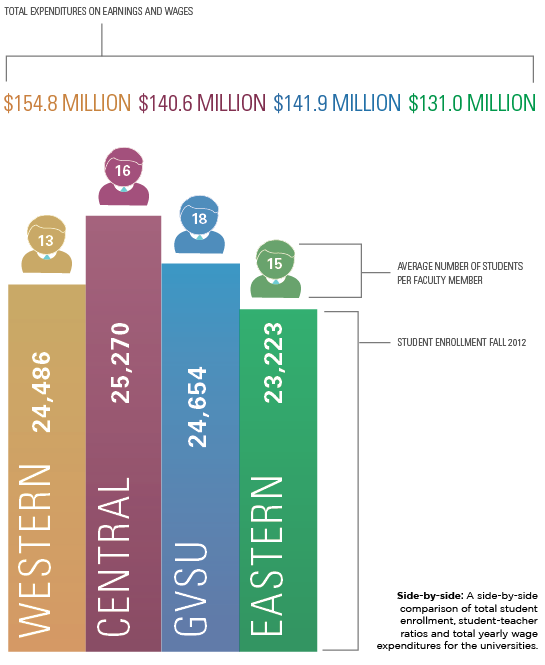GV salaries remain competitive
Mar 13, 2013
In a time of budget cuts and penny-pinching, professors and administrators at Grand Valley State University are paid less on average, but faculty members earn higher percentages of administrative salaries than those teaching at other public universities in Michigan.
On average, full professors at GVSU earn a smaller percentage of administrators’ salaries than five years ago, but they are still higher than salary percentages at other universities.
“I believe that you would find that GVSU faculty are paid comparably to the other institutions, but probably tend to be a little below the averages more often than above the averages,” said Jim Bachmeier, vice president of Finance and Administration. “We are careful not to ‘overpay’ anyone, which sometimes inflates averages at other institutions.”
In 2012, the average salary for full professors in the physics department at GVSU was $88,700, making up 35.6 percent of the president’s salary, and 37.7 percent of the provost’s salary—typically the two highest paid administrative positions at a university.
Currently, physics professors earn a slightly smaller percentage of administrators’ salaries than they did in 2007—37.5 percent of the president’s salary and 42 percent of the provost’s.
However, in comparison to other universities, data shows that GVSU physics professors generally earn a higher percentage of administrators’ salaries than at other schools, but receive a lower average salary. Calculations determined that GVSU administrators also earned less on average than other universities’ administrative staff.
For 2012, Central Michigan University physics professors averaged the smallest portion of their president’s salary at 26.8 percent. Western Michigan University professors averaged 27.5 percent, and EMU professors earned 30.5 percent.
Full professors of physics at GVSU earned the second highest percentage of their provost’s salary as compared with the other universities. WMU professors averaged 44.3 percent, CMU professors earned 37 percent, and EMU professors averaged 32.4 percent.
The data could suggest GVSU professors have a higher average salary than other physics departments, but that was not the case.
According to calculations of salary listings, GVSU physics professors earned an average salary of $88,700 during 2012, while WMU’s physics department averaged around $101,400, with CMU at $93,700 and EMU at $89,200.
“Pay rates are discipline-specific for faculty and professional staff,” Bachmeier said. “For example, engineering, health professions or business faculty have higher pay rates than some of the other disciplines.”
Looking at full professors in the GVSU management program, average salaries were 47.6 percent and 50.5 percent of the president’s and provost’s yearly earnings for 2012, which was lower than in 2007—50.7 percent and 56.8 percent, respectively.
Though the percentages have dropped over the past five years, GVSU management professors still generally earn a higher percentage of administrators’ salaries than those at other universities.
WMU business professors earned 36.9 and 59 percent of their president’s and provost’s salaries, and CMU’s numbers were at 32 and 44.3 percent. EMU’s were the closest to GVSU’s at 41.6 and 44.2 percent, respectively.
Full professors in the management program at GVSU earned about $118,600, which is above the average salary of management professors at CMU who earned $112,000, but below the others. EMU’s management professors averaged $121,500, and WMU’s averaged almost $135,000 per year.
“Salary, benefits and working conditions are key in attracting talented employees in a competitive job market,” said Matt McLogan, vice president of University Relations at GVSU. “We pay attention to compensation packages at comparable institutions.”
Compensation rates for faculty and administrative positions are set based on market data for similar positions at other universities, which is assessed locally, regionally and nationally. Internal equity is also a factor when determining salaries, according to GVSU’s human resources website.
In addition to market averages, performance, relevant experience, applicable educational credentials and responsibility also influence salaries for staff members.
“The university also differentiates pay for merit,” Bachmeier said. “The highest performers within their discipline are rewarded in the salary program.”
However, the university can’t underpay some to overpay others. “It is a balance, as underpaying hurts the quality of the university and overpaying is not good use of student tuition dollars,” Bachmeier said.
Overall, GVSU’s total expenditures for employee earnings and wages for 2012 was just under $142 million. For the same year, WMU’s total expenditure of salaries and wages was $154.8 million, the highest of the four universities examined. CMU’s was $140.6 million, and EMU’s was $131 million.
The General Fund Position List can be viewed by clicking on the Budget and Performance Transparency Reporting link found on GVSU’s homepage. For more information on employee compensation, visit www.gvsu.edu/hro.
[email protected]


























